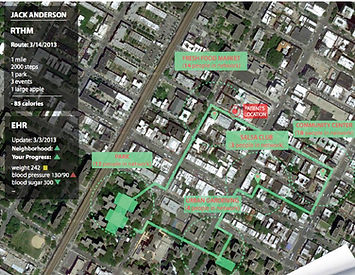REAL TIME HEALTH MAPPING 2012 onwards
Changing Lifestyle through personal environment


Changing lifestyle through directive maps RTHM provides a personal health map to spatialize lifestyle change and prescription compliance in an accessible, localized, and meaningful way. It is a simple, comprehensive, graphic visualization of the neighborhood context with all agencies and opportunities for compliance performance. For lifestyle change, potential health resources such as squares, parks, fresh food markets, community gardens, health organizations and events are visualized and linked into routes according to patient’s location and its specific health condition. Our health is out there.
PATIENT BENEFITS

NEIGHBORHOOD BENEFITS
Changing lifestyle through social networking RTHM positions and visualizes personal disease within a broader socio-spatial context, demonstrating that the patient is not the only one with the specific health problem. Through RTHM, each patient is able to externalize his or her own disease by transforming “my own problem” into “our problem to solve together.” Visualized and specialized on an aggregate level, health data creates a health-based social network that stimulates and sustains transformation of habits in the specific local setting. We are our health.
PHYSICIAN BENEFITS
Reducing re-admissions through the RTHM evidence-based health improving system, linked with Electronic Health Records, RHTM extracts necessary data for each personal health map, evaluating its own functional efficiency and continuously upgrading according to specific patient needs. Along with more efficient treatment compliance, RHTM will help physicians to exercise their full agency to address each patient’s specific health context. Help me help you.

HOSPITAL
BENEFITS
Reducing overall healthcare cost by strategic usage of the environmental health resources Linking personal health with community infrastructure allows hospitals to find treatment solutions in each patient’s socio-spatial environment, reducing re-admissions and lowering overall provider costs. Healthbased social capital created through the RTHM system is translated into significant financial benefits for both patients and hospitals. A healthy environment will save us all money.
RESPONDING TO
POLICY
> Healthy and Safe Community Environments: Create, sustain, and recognize communities that promote health and wellness through prevention. RTHM systematically maps and analyses places where we live, work, learn and play in terms of our wellness. By visualizing healthy resources in our personal surroundings, RTHM makes “healthy choices easy and affordable for each patient.”
> Clinical and Community Preventive Services: Ensure that prevention-focused health care and community prevention efforts are available, integrated, and mutually reinforcing. RTHM provides a simple framework for integrating community prevention programs with clinical treatment. Electronic health records are put to work to lower costs and improve care by plugging patients into evidence-based social and environmental networks.
> Empowered People: Support people in making healthier choices. RTHM is a mapping tool that provides a way of seeing healthier options in our personal environment. This new health-based environmental information, clearly visualized and accessible to patient and community, is a roadmap to “promote positive social interactions and support healthy decision making.” By testing community change with electronic medical records, RTHM provides the evidence base to engage and empower people and communities to exercise change.
> Elimination of Health Disparities: Eliminate disparities, improving the quality of life for all Americans By merging social, spatial, and health data on the neighborhood level, RTHM aims to identify and map high-need areas that experience poor health outcomes. Through local health providers, the application generates personal environmental prescriptions to each patient by rendering aggregate health-based environmental data in order to recognize and align existing spatial resources with community needs. RTHM becomes a tool for developing and evaluating community-based interventions that improve health outcomes and reduce health disparities.
